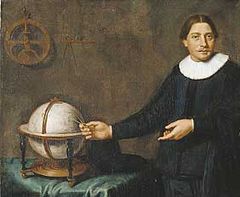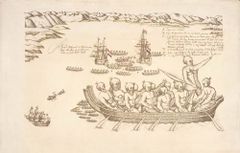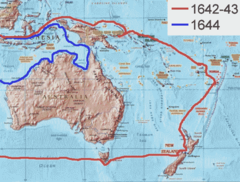Abel Tasman
2007 Schools Wikipedia Selection. Related subjects: Geographers and explorers
Abel Janszoon Tasman ( 1603 - October 10, 1659), was a Dutch seafarer, explorer, and merchant.
He is best known for his voyages of 1642 and 1644 in the service of the VOC ( Dutch East India Company). His was the first known European expedition to reach the islands of Van Diemen's Land (now Tasmania) and New Zealand and to sight the Fiji islands, which he did in 1643. Tasman, his navigator Visscher, and his Merchant Gilsemans also mapped substantial portions of Australia, New Zealand, and the Pacific Islands.
Early life
Tasman was born in 1603 in Lutjegast, the Netherlands, a village in the province of Groningen. He was first heard of at the end of 1631 when, as a widower living at Amsterdam, he married Jannetjie Tjaers. He was shortly afterwards in the service of the Dutch East India Company and by 1634 was mate of a ship trading from Batavia (now Jakarta) to the Moluccas. In July of that year he was appointed master of a small ship, the Mocha. He visited Holland in 1637 and returned to Batavia in October 1638, taking his wife with him.
First Pacific voyage
In 1639 Tasman was sent as second in command of an exploring expedition in the north Pacific. His fleet included the ships Heemskerck and Zeehaen. After many hardships Formosa (now Taiwan) was reached in November, 40 out of the crew of 90 having died. Other voyages followed, to Japan in 1640 and 1641 and to Palembang in the south of Sumatra in 1642, where he made a friendly trading treaty with the Sultan. In August 1642 Tasman was sent in command of an expedition for the discovery of the "Unknown Southland", which was believed to be in the south Pacific but which had not been seen by Europeans. Strange as it may seem to us today, Tasman sailed first to Mauritius. The reason for this was that his ships were sailing ships and the best route from one place to another was not always the direct route; of more importance was the direction of the wind. Tasman had some knowledge of the prevailing winds and so he chose Mauritius as a turning point and from there a course was set towards what was presumed to be the southern coast of Australia. (At least part of the western shore of the continent was already known to the Dutch, but the shape of the southern coast was unknown).
Tasmania
On 24 November 1642 he sighted the west coast of Tasmania near Macquarie Harbour. He named the land Van Diemen's Land after Anthony Van Diemen the Governor-General of the Dutch East Indies. Proceeding south he skirted the southern end of Tasmania and turned north-east until he was off Cape Frederick Hendrick on the Forestier Peninsula. An attempt at landing was made but the sea was too rough; however, the carpenter swam through the surf, and, planting a flag, Tasman took formal possession of the land on 3 December 1642.
New Zealand
Tasman had intended to proceed in a northerly direction but as the wind was unfavourable he steered east. On 13 December they sighted land on the north-west coast of the South Island, New Zealand. After some exploration he sailed further east, and nine days later was the first European known to sight New Zealand, which he named Staten Landt on the assumption that it was connected to an island ( Staten Island, Argentina) at the south of the tip of South America. Proceeding north and then east one of his boats was attacked by some Māori in war canoes, and four of his men were killed. It has recently been suggested that some of Tasman's sailors briefly landed here on 18 December 1642. Tasman named it Murderers' Bay (now known as Golden Bay) and sailed north, but mistook Cook Strait for a bight (naming it Zeehaen's Bight). Two names that he bestowed on New Zealand landmarks still endure: Cape Maria van Diemen and Three Kings Islands (Cabo Pieter Boreels is now known as Cape Egmont).
The return voyage
En route back to Batavia, he came across the Tongan archipelago on January 21, 1643. While passing the Fiji Islands Tasman's ships came close to being wrecked in one of its reef-lined bays. Eventually turned north-west to New Guinea, and arrived at Batavia on 15 June 1643.
Second Pacific voyage
With three ships on his second voyage ( Limmen, Zeemeeuw and the tender Braek) in 1644, he followed the south coast of New Guinea eastward. He missed the Torres Strait between New Guinea and Australia, and continued his voyage along the Australian coast. He mapped the north coast of Australia making observations on the land and its people.
From the point of view of the VOC Tasman's explorations were a disappointment: he had neither found a promising area for trade nor a useful new shipping route. For over a century, until the era of James Cook, Tasmania and New Zealand were not visited by Europeans - mainland Australia was visited, but usually only by accident.
Later life
On 2 November 1644 he was appointed a member of the council of justice at Batavia. He went to Sumatra in 1646, and in August 1647 to Siam (now Thailand) with letters from the company to the King. In May 1648 he was in charge of an expedition sent to Manila to try to intercept and loot the Spanish silver ships coming from America, but he had no success and returned to Batavia in January 1649. In November 1649 he was charged and found guilty of having in the previous year hanged one of his men without trial, was suspended from his office of commander, fined, and made to pay compensation to the relatives of the sailor. On 5 January 1651 he was formally reinstated in his rank and spent his remaining years at Batavia. He was in good circumstances, being one of the larger landowners in the town. He died at Batavia in October 1659 and was survived by his second wife and a daughter by his first wife. His discoveries were most important but led to nothing for more than 100 years.

Tasman's legacy
As with many explorers, Tasman's name has been honoured in many places. These include:
- the island of Tasmania, including features such as
- the Tasman Peninsula
- the Tasman Bridge
- the Tasman Highway
- the passenger/vehicle ferry Abel Tasman
- the Tasman Sea
- in New Zealand:
- the Tasman Glacier
- the Tasman River
- Mount Tasman
- the Abel Tasman National Park
- Tasman Bay
- the Tasman District


